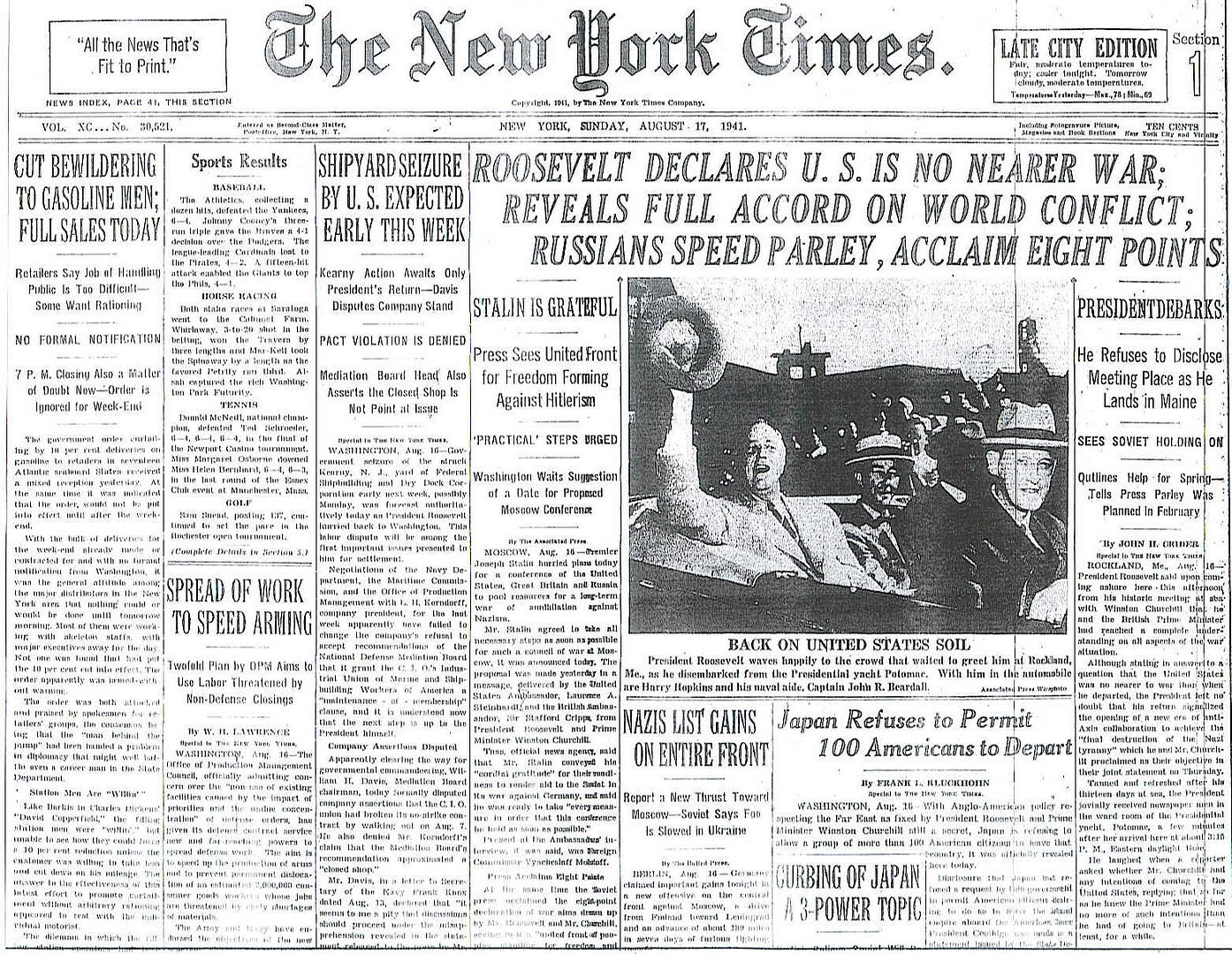
Posted on 08/17/2011 4:37:59 AM PDT by Homer_J_Simpson

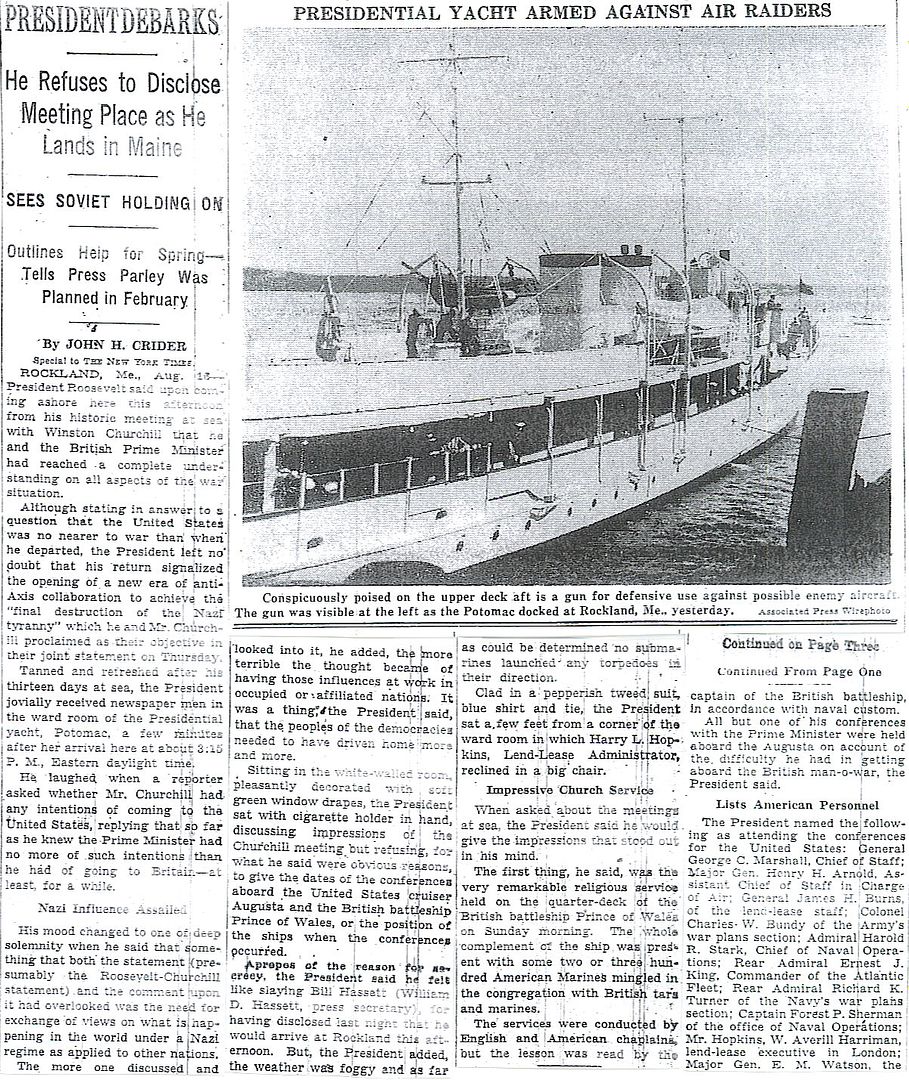

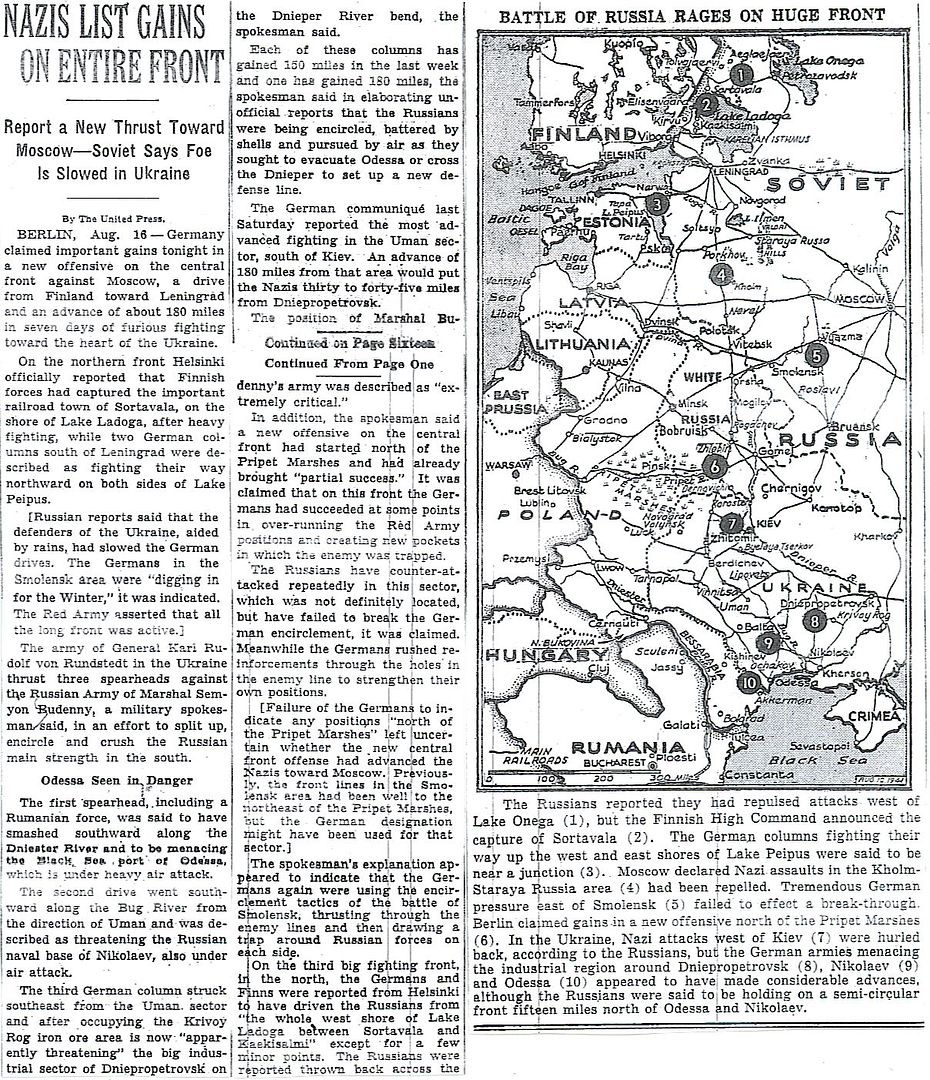
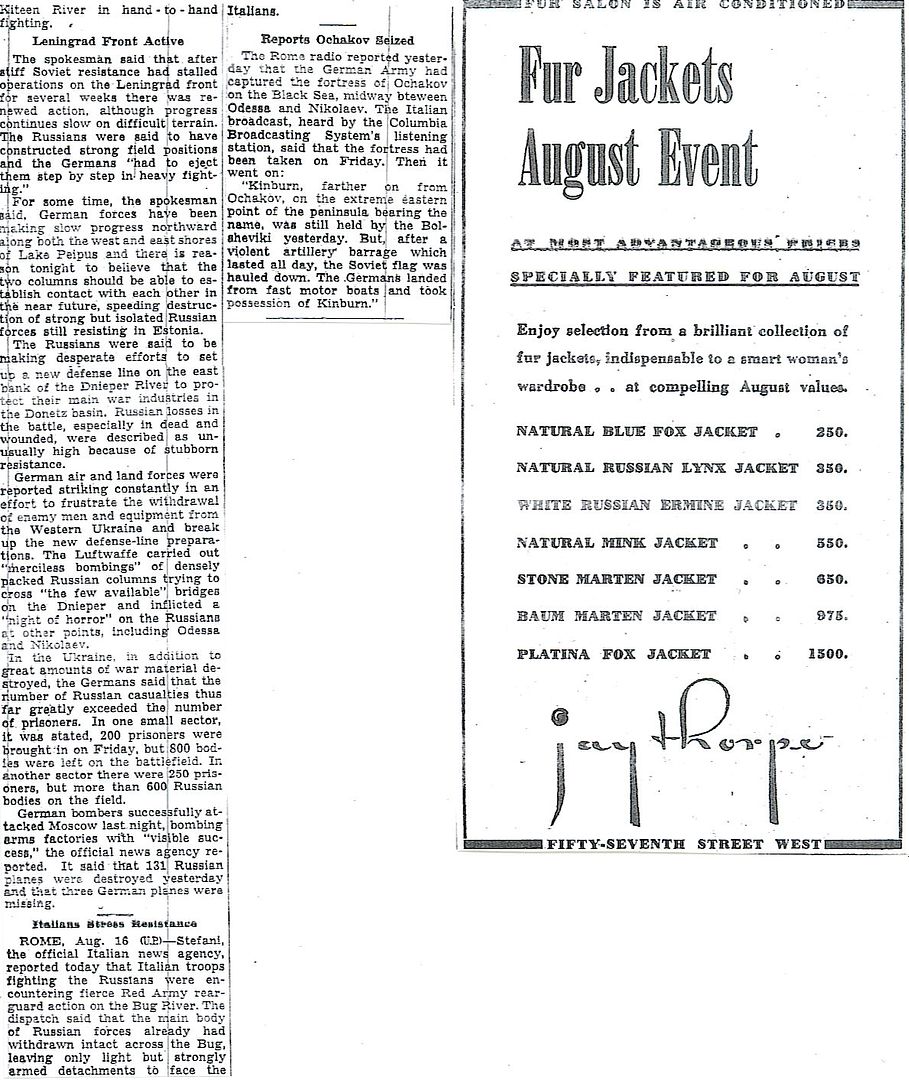
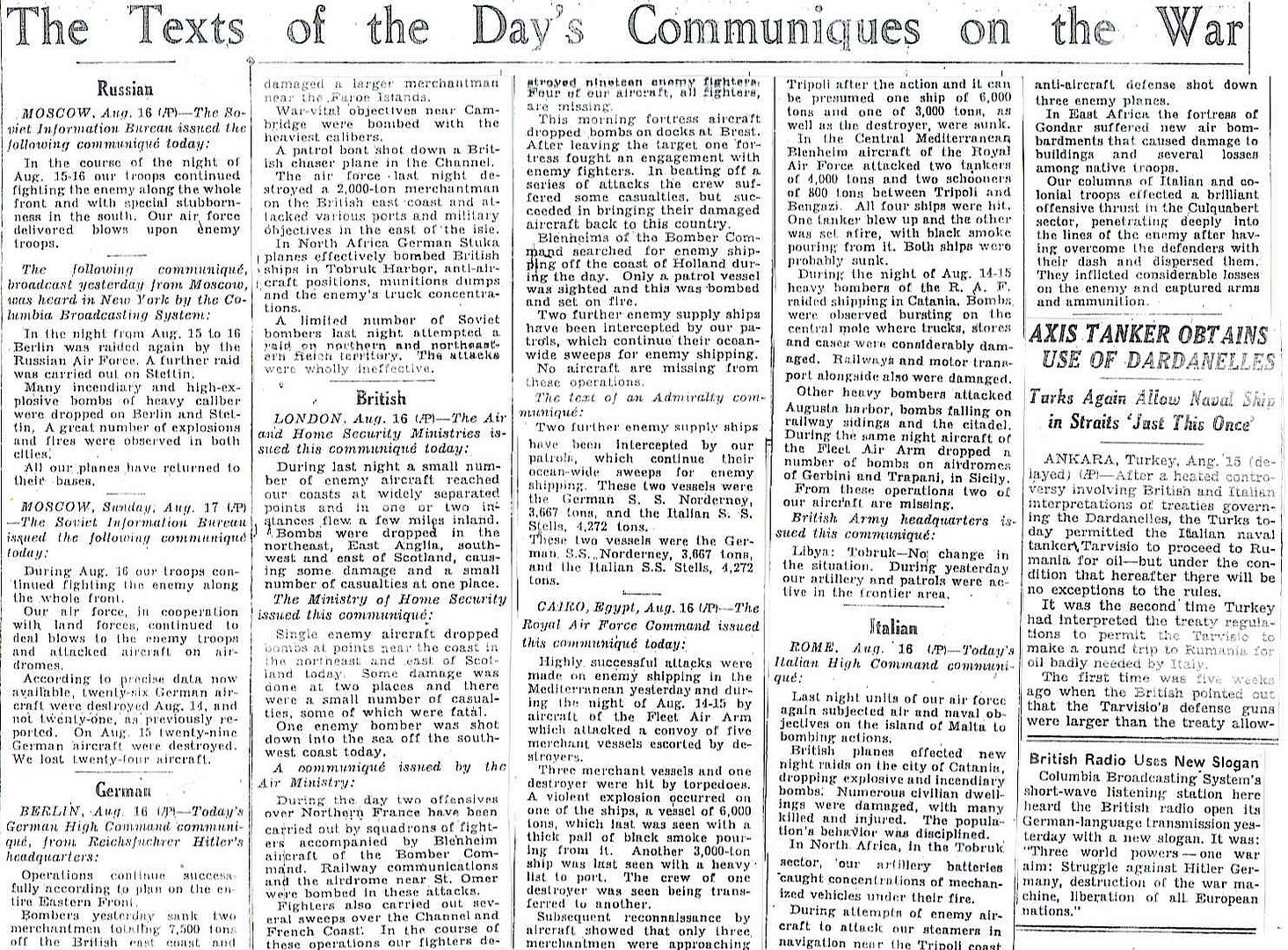
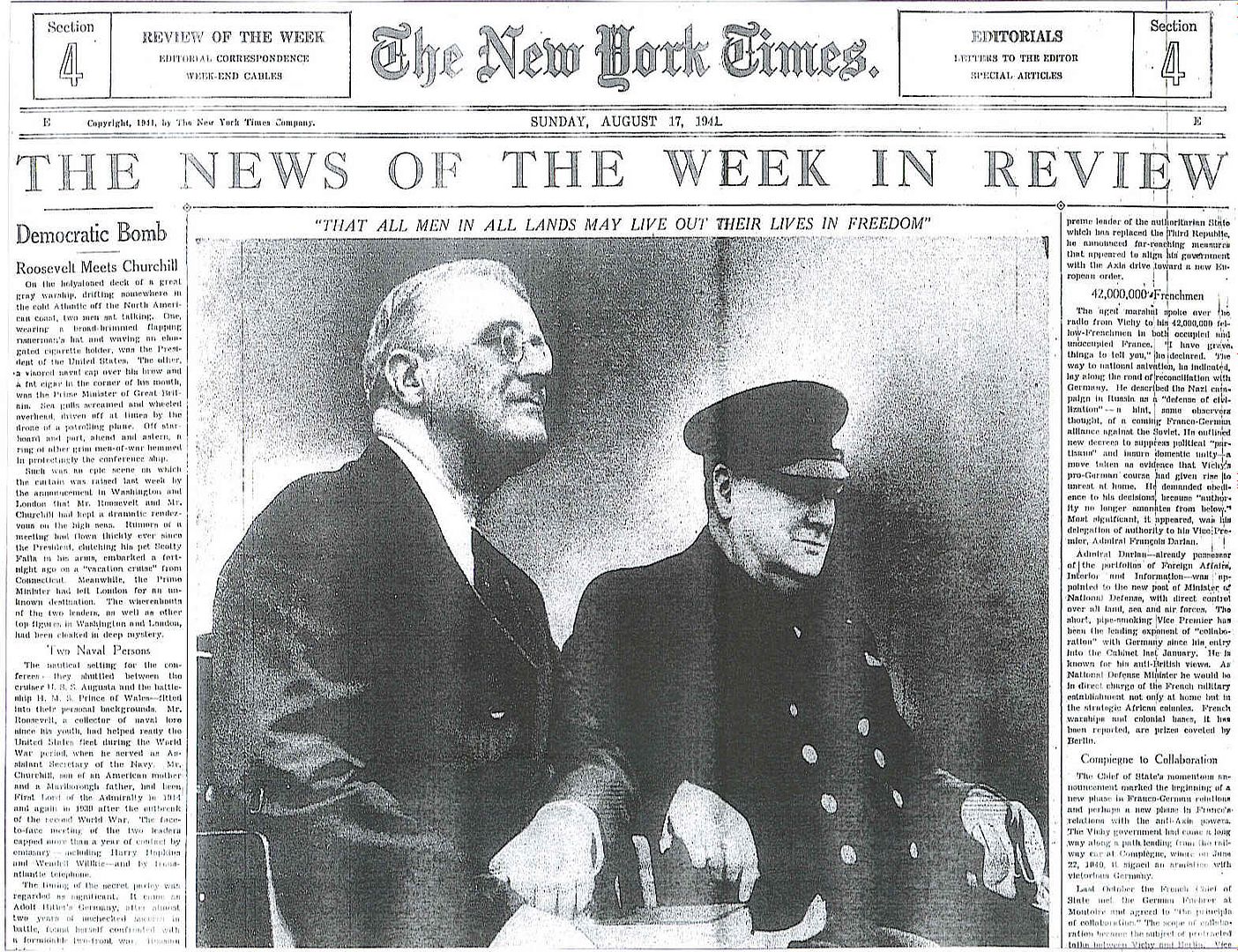
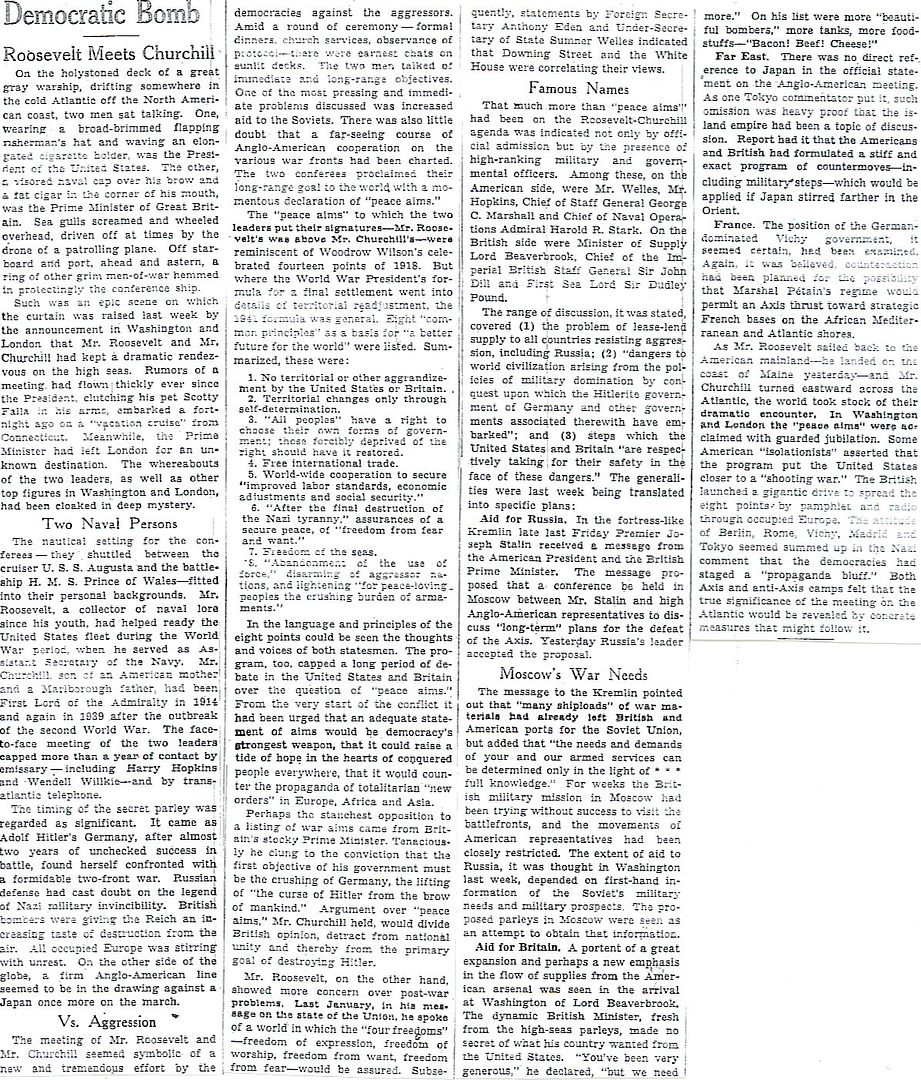
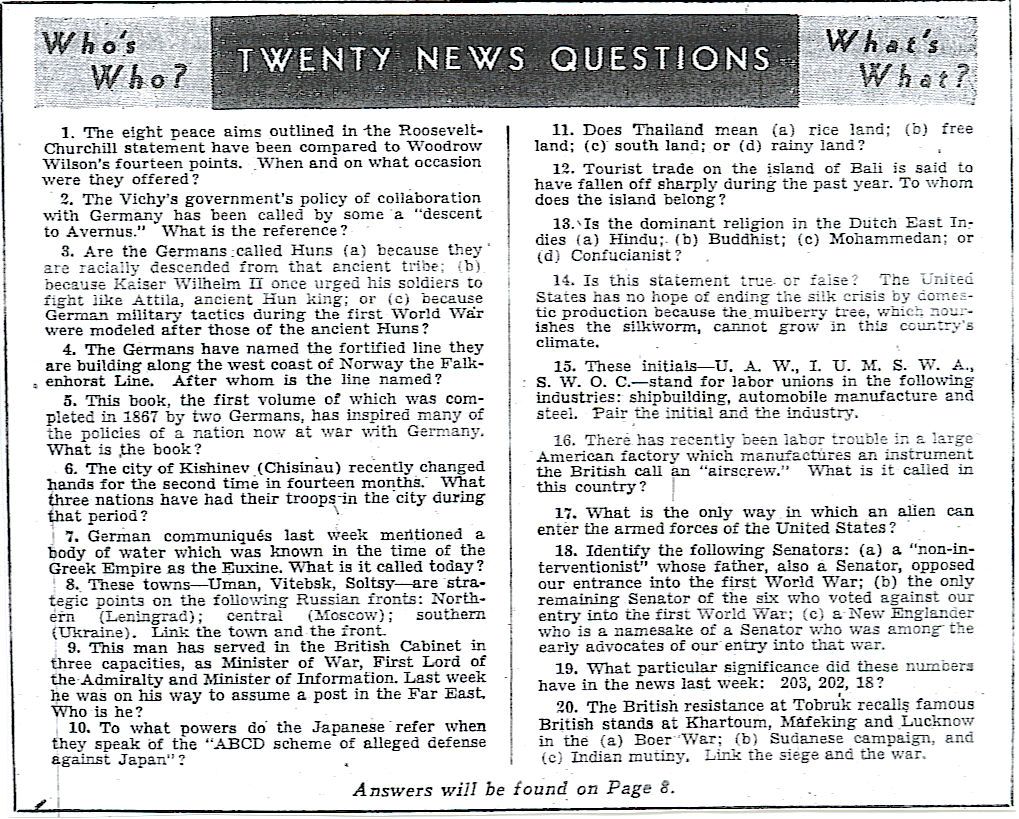
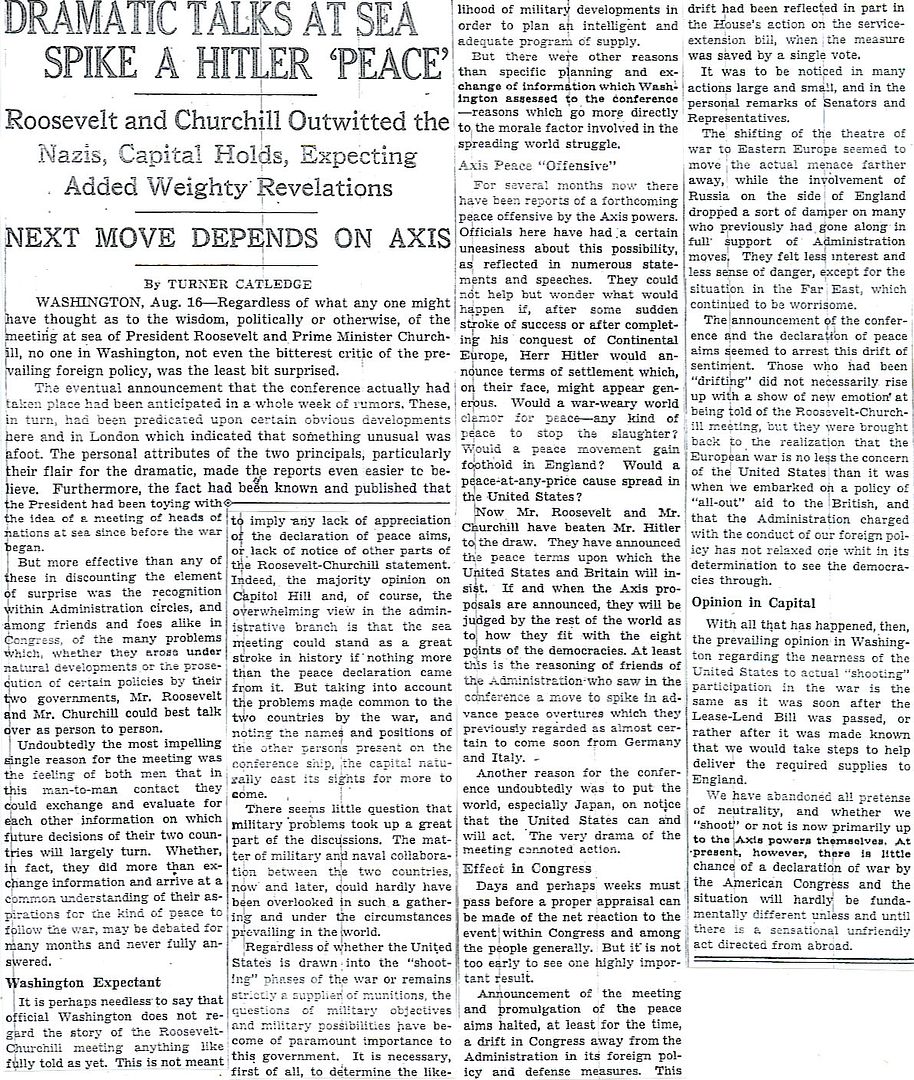
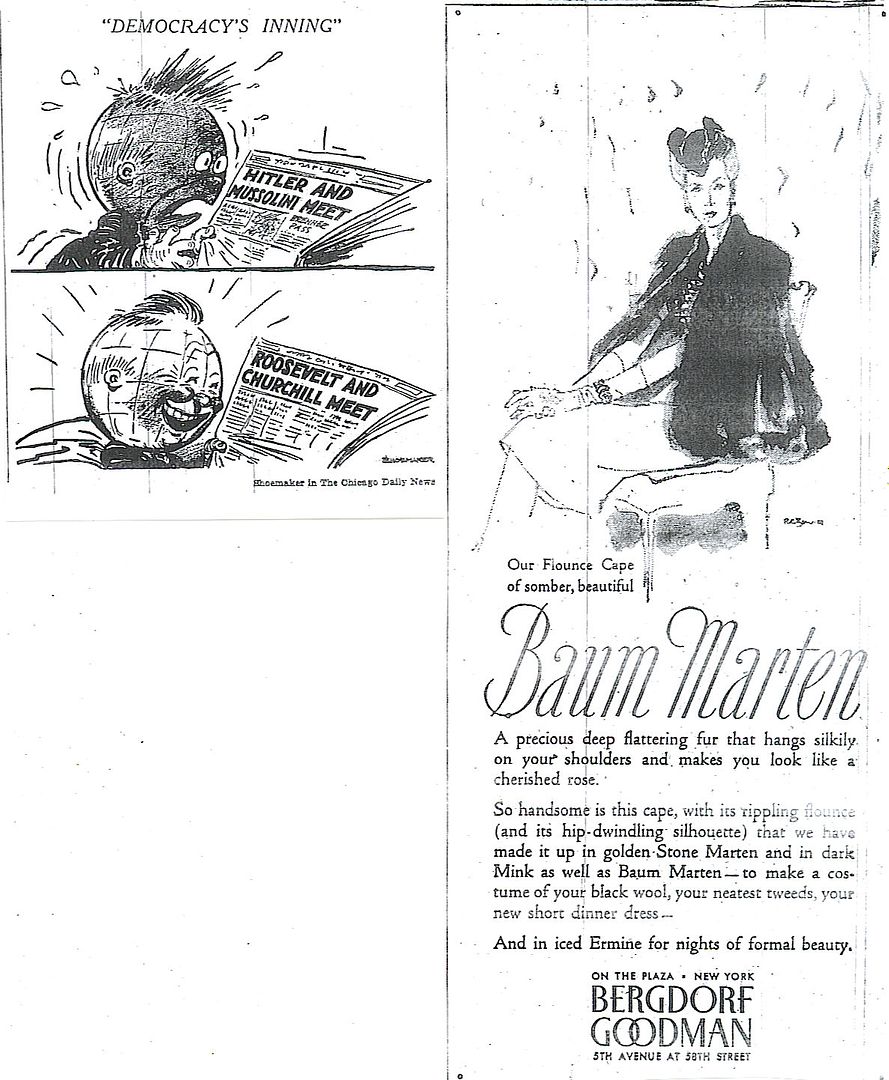
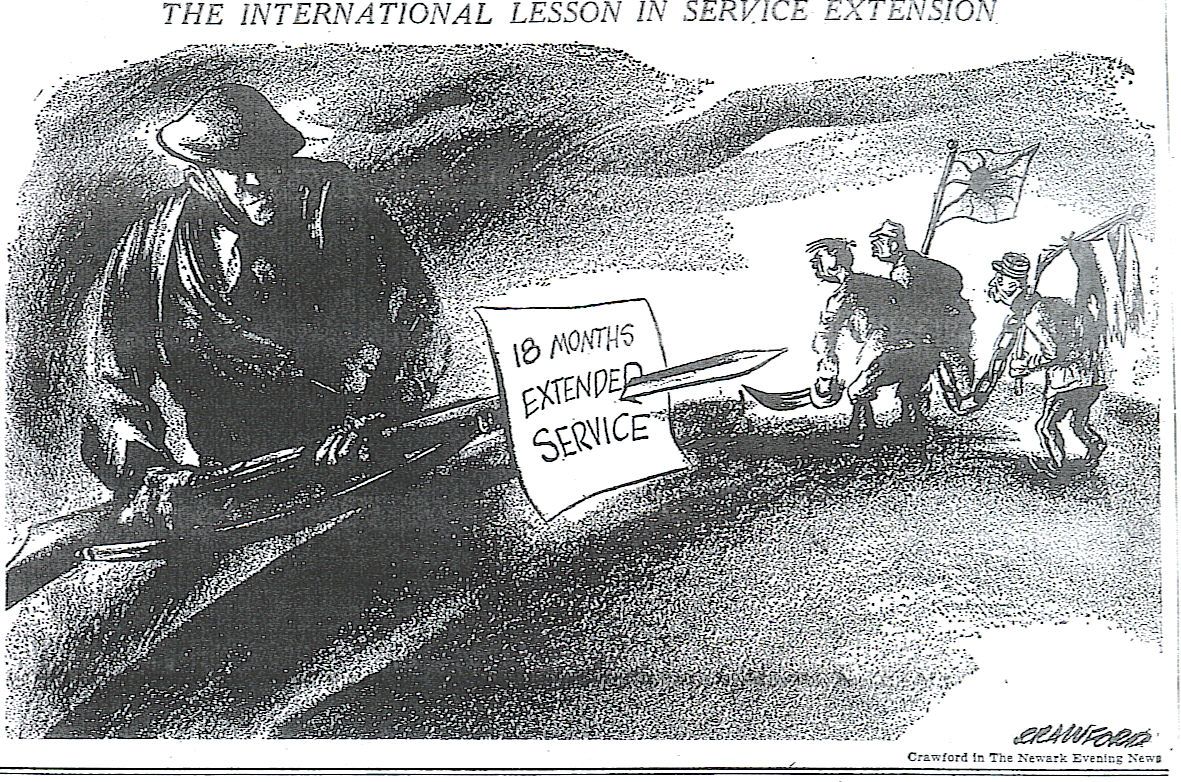
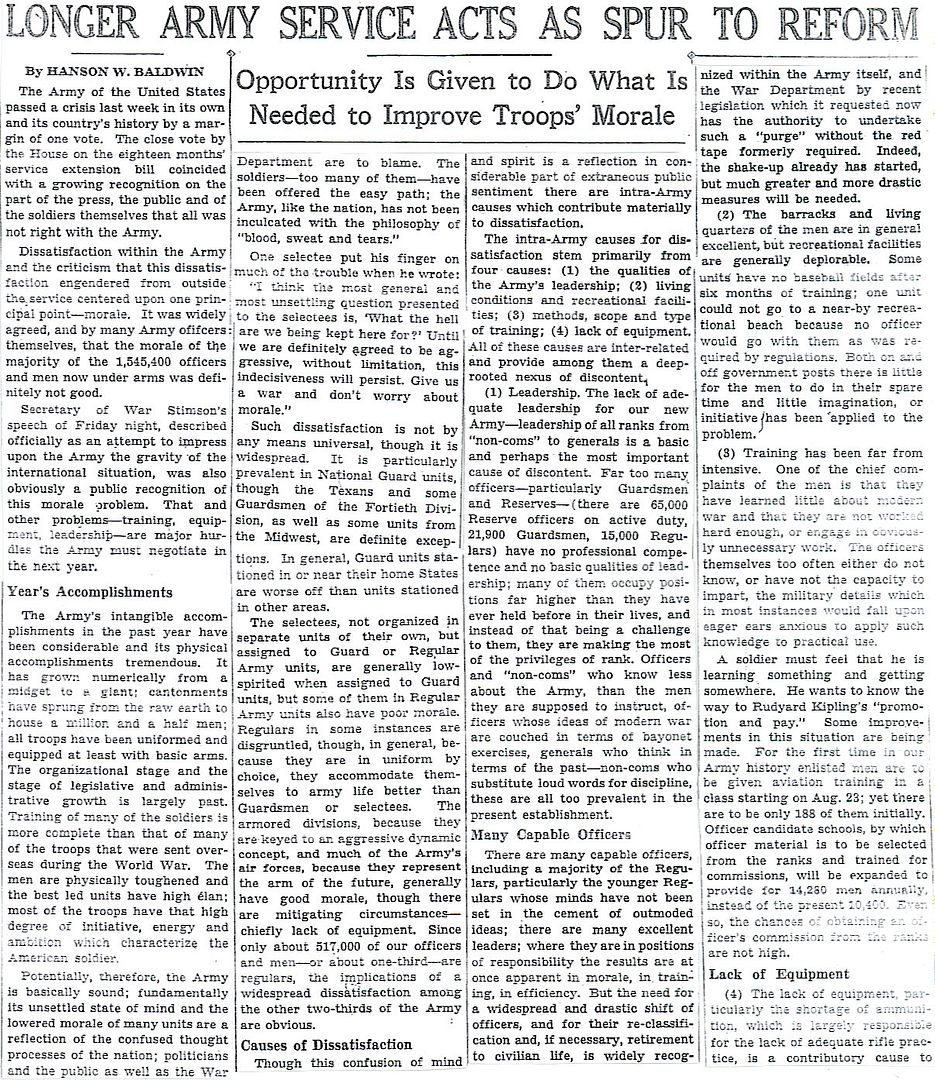
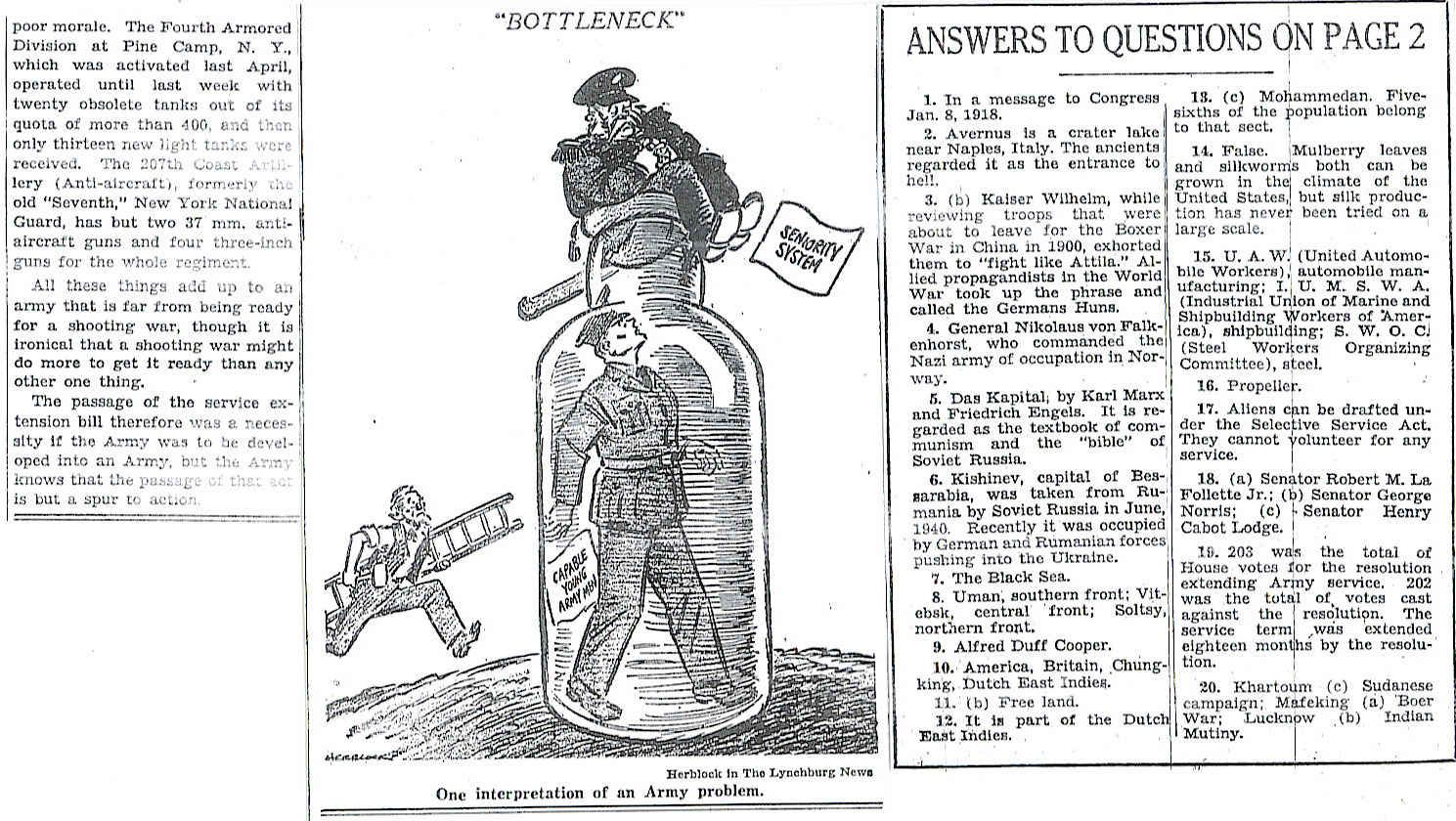
The News of the Week in Review
Democratic Bomb – 8
Twenty News Questions – 9
Dramatic Talks at Sea Spike a Hitler ‘Peace’ – 10
Longer Army Service Acts as Spur to Reform – 13-14
Answers to Twenty News Questions – 14
http://www.onwar.com/chrono/1941/aug41/f16aug41.htm
Convoy escapes attacks unscathed
Saturday, August 16, 1941 www.onwar.com
In the North Atlantic... Since August 9th, 8 German and 3 Italian submarines have made repeated, though unsuccessful, attacks on convoy HG-69, northwest of Gibraltar.
http://homepage.ntlworld.com/andrew.etherington/month/thismonth/17.htm
August 17th, 1941
UNITED KINGDOM: London: Britain and the USSR protest to Iran about the large number of German “tourists” in Iran.
Great Britain and the Soviet Union sign a trade accord. (Jack McKillop)
U.S.S.R.: The German Army’s Heeresgruppe Nord (von Leeb) in its drive toward Leningrad captures Narva while Heeresgruppe Süd (von Rundstedt) reaches the Dniepr River at Dnepropetrovsk. Novgorod on the shores of Lake Ilmen and the Black Sea naval port of Nikolayev also falls to the Germans. (Jack McKillop)
Soviet submarine SC-216 commissioned. (Dave Shirlaw)
Soviet submarine Shch-307 is mined near Suuraari Island. (Mike Yared)(146 and 147)
CHINA: The Nationalist government endorses the Anglo-US Atlantic Charter.
U.S.A.: President Franklin D Roosevelt and Secretary of State Cordell Hull talk with Japanese Ambassador Nomura Kichasaburo. The Americans state their conditions for resuming negotiations with the Japanese. A US note to Japan is formally presented. This note maintains the lines as agreed at Placentia Bay. Since it is toned down from what was originally agreed, the British and Dutch governments do not present their notes at this time. (Jack McKillop)
"About 110,000 Jews lived in Lvov, Ukraine, before the war.
Occupied by the Germans in June 1941, Lvov became the site of brutal Ukrainian pogroms against Jews from July 25 to 27, 1941.
They were called the Petliura Days because they commemorated the death of Ukrainian Premier Simon Petliura, who orchestrated pogroms against Jews in 1919. Two thousand Jews were killed in the July 1941 pogroms."
"The details of this photograph, which was probably snapped in Lvov, Ukraine, are in doubt.
Some sources claim the woman is a captured British agent.
Others insist she is a Jew who fell into the hands of antisemitic Ukrainians.
Whatever the story behind this disturbing image, there is little doubt that the woman has been stripped and humiliated, probably as a prelude to her execution.
The Nazis and their most eager collaborators seemed to take particular relish in this most base sort of domination, degrading Jewish and other women in order to demoralize, as well as for sheer "sport." "
On 29 August 1941 the Germans organised the first volunteers into armed units - ten Estonian, Russian and Ingermanland security battalions and the 'Anti-Partisan Regiment' (Freijagerregiment) in Army Group North, and five combat battalions (Kampfbataillone) in Army Group Centre. Attached to German divisions on anti-partisan duties or as front-line reinforcements these troops consistently proved their commitment and combat value: on 6 October 1941 mass recruitment of Soviet nationals as 'Eastern Troops' (Osttruppen) was permitted.
The first Cossack unit in the German army was the Red Army's 436th Infantry Regiment, which defected on 22 August 1941, and from October 1941- 11 Cossack cavalry squadrons were raised for anti-partisan duties with security divisions, or mounted reconnaissance for Panzer divisions, usually with one squadron (Sotnia) per division: in late 1942 these expanded to 11 battalions. In 1942 three mounted regiments, three infantry regiments and six infantry battalions were recruited with Cossack field officers.
From 15 November 1941 seven security companies were raised from inaccurately labelled 'Turkic' Caucasian and Soviet middle-eastern nationalities, and in 1942 they expanded into six 'Eastern legions' (Ostlegionen) in occupied Poland: Armenian, Azerbaijan, Georgian, North Caucasian (Ossetians, Ingushes and Chechens etc.), Turkestan (Kazakhs, Kirkhiz, Tajiks, Turkmens, Uzbeks etc.) and Volga-Tartar (Kazan Tartars, Bashkirs, Chuvashes, Udmurts etc.) Up to the fall of Stalingrad the legions recruited civilian volunteers into five ordnance, construction, and transport battalions and 200 supply and transport companies. Ex-Red Army troops joined 34 infantry battalions numbered in the 783-844 series, and 28 field battalions carrying the divisional number, but only 28 battalions saw action on the eastern front, mostly in the Caucasus.
From 1 October 1942 Estonian, Russian, Belarussian and Ukrainian units were designated as 'Eastern battalions', mostly with Army Group Centre. Each battalion (Ostbataillon), about 950 strong, was allocated a German commander and a cadre of 36 German officers, NCOs and men. In January 1943 the 48 Eastern battalions (except Estonian battalions 658-660) and all Russian, Belarussian and Ukrainian Hiwis were nominally united as the Russian Liberation Army (Russkaya Osvoboditel'naya Armiya, or ROA).
The German Army In World War II by Nigel Thomas
During the night of 9th August, a clear, starry summer night, the divisions of I Corps from East Prussia silently moved into their jumping-off positions for the offensive across the wide, marshy Mshaga river. The cornerstone of Leningrad's defenses was to be overturned at last.
The main weight of the attack was borne by General Sponheimer's 21st Infantry Division, which, reinforced by 424th Infantry Regiment, 126th Infantry Division, was to advance along the strongly fortified main road towards Novgorod. The ground was tricky even for infantry. Swamps, thick undergrowth, and numerous streams and river-courses made movement difficult. The Russians, moreover, had developed the whole area into a fortress: there were pillboxes, minefields, machine-guns nests, and mortar positions blocking what few roads and paths led through the swampy ground.
In the grey light of dawn formations of VIII Air Corps had set out from their bases and had been dropping their bombs since 0400 hours on the enemy positions on the far bank of the Mshaga. Stukas made screaming low-level attacks, skimming across the river at barely 150 feet, dropping their bombs on dug-outs, gun positions, and machine-gun posts. The military machine was working with great precision. No sooner had the last bomb been dropped than 200 guns of all calibres opened up. It was a classic preparation for an attack. At 0430 hours exactly the company commanders of 2nd and 3rd Battalions, 3rd Infantry Regiment, as well as 1st Battalion, 45th Infantry Regiment, leapt out from their hideouts. The men dragged inflated dinghies to the river-bank and, under cover of the artillery umbrella, ferried themselves across. Together with the infantry the sappers also crossed the Mshaga, and on the far bank cleared lanes through the minefields for the assault detachments following hard on their heels.
To start with everything went surprisingly smoothly. The enemy seemed to have been utterly shattered by the preliminary aerial and artillery bombardment. His heavy weapons and artillery were silent. Ducking low, the assault detachments ran along the white tapes with which the sappers had marked out the cleared lanes through the minefields. The bridgehead was secured. The first heavy weapons were ferried across the river. Then the barges were linked to form a bridge. By twelve noon it was ready. The division moved into the bridgehead.
The 24th Infantry Regiment was now also brought forward. Slowly the enemy recovered from his shock. Resistance was getting stiffer. In the late afternoon the 24th Infantry Regiment took the village of Mshaga. By nightfall the Soviet defenses had been pierced to a depth of five miles. The following day Shimsk, at first to be bypassed, fell to the Germans.
On 12th August the Ushnitsa river was forced by a frontal attack. The infantrymen were weighed down by their weapons and ammunition-boxes. Everything had to be carried. The Russians were resisting stubbornly. Along the railway embankment especially they contested every inch of ground. The Soviet soldiers continued to fire until they were killed in their foxholes or blown up by hand-grenades. In the face of such opposition how was progress possible?
Furious battles were waged for every inch of ground.
The regimental headquarters of 45th Infantry Regiment was in a roadside ditch before Volinov. The mood was despondent. Reports of casualties were shattering. Colonel Chill, the regimental commander, used the field telephone, which had been laid right up to that point, to speak to division. "The Stukas must go in once more," he implored his superiors. Just then a runner jumped down into the ditch—Lance-corporal Willumeit. Somewhat out of breath, he saluted the regimental commander.
" Message from 2nd Battalion, sir: Lieutenant-Colonel Matussik sends this captured enemy map. It was taken from a Soviet major killed in action. Evidently he was ADC to a senior commander."
Colonel Chill cast one glance at the map and looked up in amazement.
"My friend, for that you shall have my last cigar but one," he said to the runner, pulling out his cigar-case.
Willumeit beamed, accepted the cigar, and said, "I shall take the liberty of swapping it, Herr Oberst—I don't smoke." Everyone joined in the laughter. The map was a precious find. It showed the Soviet Forty-eighth Army's entire position along the Verenda, until then unknown, complete with all strong-points, dummy positions, gun emplacements, and machine-gun posts. It was largely due to this captured map that on the following day these positions were pierced in a bold action. That is how fate—or, if you prefer it, blind luck—takes a hand in battle. That was what Frederick the Great, the King of Prussia, meant when he said, "Generals must not only be brave, they must also have la fortune.”
General Sponheimer could not complain of any lack of la fortune before Novgorod. In addition to the captured map, Fortune —again in the form of the 45th Infantry Regiment— sent him a priceless prisoner. He had been found with a column of Soviet supply lorries by a bicycle reconnaissance detachment. He was a sapper officer from the staff of the Soviet 28th Rifle Division—a man from Karelia, Finnish by birth, and with no love for the Bolsheviks.
"Nix Bolshevik,"he kept assuring the German second lieutenant. Shortly afterwards, when an interpreter had been fetched, an amazing sequence of events began.
"I know all the fortifications," said the Karelian.
"The papers are hidden in the forest," he added slyly.
"You trying to pull our leg?" the second lieutenant asked.
The Karelian raised three fingers. "I swear by my mother!"
The lieutenant threatened him with his pistol.
"Don't try anything funny—an ambush or something of that kind! Or you'd better start praying."
The interpreter translated. The Karelian nodded. "Let's go then," the lieutenant decided. He himself led his platoon into the near-by forest, cautiously, covering the Karelian all the time. The Karelian did not have to search long. In a thick clump of shrubs, underneath a large boulder, was his sailcloth bag—a big parcel. It contained all the fortification maps of Novgorod as well as the plans of the minefields.
The lieutenant took the packet, complete with the Karelian, straight to the divisional Intelligence officer. The Intelligence officer grabbed it and raced across to the chief of operations, Major von der Chevallerie. The major was almost beside himself with delight. The maps clearly showed the entire defences outside Novgorod, including the defences of the city itself and the fortifications on the small island in the Volkhov between the two main parts of the city. After that it was not difficult to pierce the Russian positions at the crucial points and to get to the edge of the city itself without too many casualties.
On the morning of 15th August the 3rd Infantry Regiment saw the famous "Novgorod the Golden" spread out in front of them in the morning sun. Novgorod—one of the most ancient Russian settlements, founded by Rurik the Conqueror as his residence in the ninth century, administered in the Middle Ages in accordance with Lübeck city law, depopulated several times by black death and cholera, always rising anew from its ashes. Novgorod, known as "the Golden" because of its important and profitable fur and salt trade with the Hanseatic cities of Germany. Because of its wealth the city was twice sacked completely within a century, by Ivan III and Ivan the Terrible, and its citizens deported or slaughtered. Forty-seven magnificent churches with fine old frescoes surrounded the Kremlin of Novgorod which commanded the bridges over the Volkhov. A proud city, never conquered. Throughout its thousand-year history Novgorod had never, until 1941, been occupied by a foreign enemy, apart from a very brief episode in the Nordic War at the beginning of the seventeenth century. But now Russia's golden city was about to suffer that humiliation. On 15th August 1941 the 21st Infantry Division from East Prussia intercepted a signal from Moscow to the Soviet Fortyeighth Army. It ran: "Novgorod is to be defended to the last man." As chance would have it, it was the Soviet 21st Armoured Division which was to defend Novgorod to the last man, against the attack of the German 21st Infantry Division.
At 1730 hours on 15th August VIII Air Corps began a heavy air raid on the Russian positions along the city's battlements, and kept it up for twenty minutes. Novgorod stood in flames. The three infantry regiments of 21st Infantry Division lined up for the assault. From the edge of the ancient moat came the stutter of machine-guns, the crash of guns, and the plop of mortars. To be held to the last man! "To the last man," repeated the commissars. With their pistols drawn they stood at their posts until death relieved them of their duty. At first light on 16th August the German assault companies were inside the blazing city. At 0700 the 1st Battalion, 424th Infantry Regiment, of 126th Infantry Division—for this attack under the command of 21st Infantry Division—hoisted the swastika over Novgorod's Kremlin.
But there was no time for victory celebrations. The objective was Chudovo and the October Railway. "Keep going," Major von Glasow, commander of the reconnaissance detachment and now leading the hurriedly formed vanguard of 21st Infantry Division, urged his men. The men of the bicycle companies of 24th and 45th Regiments pedalled for all they were worth. The cavalry squadrons moved off at a trot, followed by the motorized platoon of Panzerjägers and by heavy motorized batteries of 2nd Battalion, 37th Artillery Regiment. There were no tanks at all, and only a few selfpropelled guns of Assault Gun Battery 666. The brunt of the fighting was borne by 37th Artillery Regiment, as well as the heavy artillery battalions, Mortar Battalion 9, and Army AA Battalion 272, all of them grouped under Artillery Commander 123. - In that way the companies of 45th Infantry Regiment made their assault. On 20th August, towards noon, Sergeant Fege with his platoon rushed the road bridge leading over the Kerest stream towards Chudovo from the south-east and seized it by a surprise coup. Second Lieutenant Kahle occupied the railway bridge over the Kerest before the Soviet bridge guard was able to touch off the démolition charge. Meanwhile the 24th Regiment took the bridge which carried the October Railway. They captured it intact. And that was not all. That day seemed an unending string of lucky incidents. Lieutenant-Colonel Matussik with his 2nd Battalion, 45th Infantry Regiment, with great presence of mind seized the chance to drive on towards the east. There lay the huge railway bridge over the Volkhov, the line to Moscow. In a captured lorry Matussik drove right up to the bridge. There was no guard. On and across! The battalion raced over to the other side of the river.
It was shortly to become a fateful river for Army Group North.
-To Be Continued>
Hitler Moves East-Paul Carell
Summer grave of German Panzerjager unit in Army Group Center 1941
Soviet tanks which had to be pushed off a major road near Gomel Aug 1941
German medics looking for supplies in Soviet tank (Lepel-Senno road) Aug 1941
Two landser "confiscate" abandoned KV-2 Soviet tank for their unit. Latvia Aug 1941
Soviet KV-2 which crashed through peasant basement near Fastov, Ukraine Aug 1941
Two Soviet tanks which were guarding Podliski(?) village-Tank on right was destroyed by German engineers using explosive charges. July 12th, 1941
German police looking for weapons cache in village. Several rifle and crates of grenades were discovered. Ukraine-late August 1941
Part of a large Soviet convoy destroyed by air (Stuka) attack along approaches to Dneiper river near Uman. Summer 1941
Soviet POWs take group photo in eastern Poland. They are a work party assisting the German army. July 1941
German "collectors" look for anything useful in huge Russian tank which ran out of fuel near Pskow in Northern Russia-Aug 1941
An undercover priest who had been living among villagers for 15 years. All the people in the village kept his secret including a party functionary in the collective farm. Name of town appears to be censored although the date is July 17th, 1941
Germans bury their comrades all of whom were killed in taking this village-near Jarzevo on the main Moscow road. Late August 1941
Yet another KV-2 found on the road. Tank couldn't be driven because the transmission was damaged. Army Group Center-Aug 1941
Group of Soviet POWs who were surprised by a German Panzer attack on their village-all their officers and equipment were also captured. Near Orscha -west of Smolensk July 1941
KV-2 surprised by German recce troops near the road to Nevel. The crew later surrendered to German troops. No location or date given Summer 1941
German supply troops who have "volunteered" to join combat units receive a once-over by regimental medics. Minsk-July 1941
German units "confiscates" Soviet tank. Tank is out of fuel but in perfect order. Sixth Army-northern Ukraine-July 1941
Another signpost on the road east-1941
German infantry search swamps near the town of Welikije Luki-August 1941
Soviet tank destroyed by plate (teller)mine in area of sixth army in the northern Ukraine Aug-Sept 1941
No date or caption
SS motorized troops and prisoner drive in convoy -area of Dneiper river Aug 1941
Russian tank destroyed by Panzer-Jager unit in the Ukraine-Sept 1941
German troops in bivouac near Vjasma in late Sept find the the evening is already chilly.
16. What is the only way in which an alien can enter the armed forces of the Unites States?
Aliens can be drafted under the Selective Service Act. They cannot volunteer for any service.
I found the above interesting. Makes perfect sense, this way the military controls who gets in. A spy can’t volunteer.
What are the current rules now that we don’t have a draft?
Fireside Chat Depends On Press, President Says
Rockland, ME. When someone asked President Roosevelt at his press conference here today if he intended to go on the radio in a fireside chat or in some other way to discuss the new developments resulting from his talks with Prime Minister Winston Churchill, the President permitted direct quotation of the following reply:
“It’s up to you fellows. If you fellows give the country an exceedingly correct picture, I won’t go on the radio.”
The President permitted the direct quotation when a radio representative whispered that the newspapers would not print that anyway.
Disclaimer: Opinions posted on Free Republic are those of the individual posters and do not necessarily represent the opinion of Free Republic or its management. All materials posted herein are protected by copyright law and the exemption for fair use of copyrighted works.